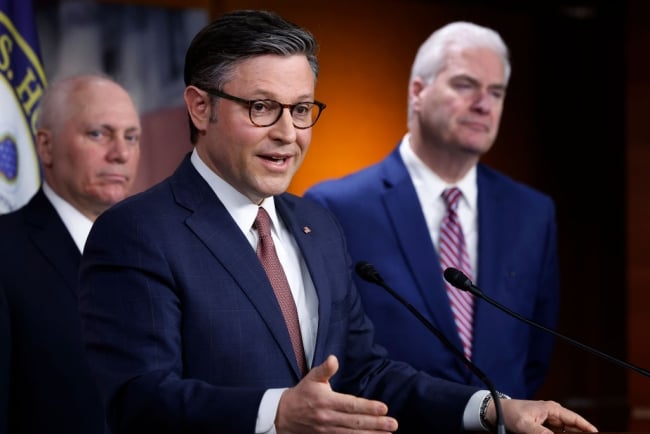You have /5 articles left.
Sign up for a free account or log in.

House Speaker Mike Johnson at a Republican caucus meeting Wednesday morning. The spending bill released Thursday puts an end to a fraught, unusually long budget cycle in which Johnson unseated Kevin McCarthy.
Chip Somodevilla/Getty Images
After a fraught and drawn-out appropriations cycle, Congress released its final $1.2 trillion package of spending bills early Thursday morning. The measures would provide little in the way of new funds for programs important to colleges, largely aligning with the Senate’s proposed budget and avoiding billions of dollars in cuts suggested by House Republicans.
If the legislation passes, the Education Department would receive $79.1 billion, a relatively small $500 million decrease from last year’s budget.
“It’s pretty much what we expected,” said Emmanual Guillory, senior director of government relations for the American Council on Education. “We figured it would be closer to the Senate’s proposal than the House’s.”
Total federal student aid assistance would be flat-funded at $24.6 billion, about $1.8 billion less than the Biden administration requested. The maximum yearly Pell Grant award per student will remain at $7,395, in line with the budget deal reached last January. The Biden administration had proposed doubling the maximum Pell Grant per student, a request that Congress summarily dismissed.
That the maximum Pell award will remain stagnant is a sore spot for many equity advocates, especially since the Biden administration requested a $750 increase just last week. Congress has approved modest elevations to that threshold for the past several years; it has risen $900 since president Biden took office.
“The failure to increase investments in those programs is particularly damaging for Black, Latino, and Native students and students from low-income backgrounds,” Augustus Mays, vice president for partnerships and engagement at the nonprofit advocacy group Education Trust, wrote in a statement.
The Office of Federal Student Aid would receive a little over $2 billion for administration of financial aid programs to support initiatives such as the rollout of the new Free Application for Federal Student Aid. That’s about $2.9 billion less than the Biden administration requested but a $25 million bump over what was agreed upon last January after Congress denied repeated calls for more FSA funding over the preceding year to support student debt relief and the FAFSA overhaul.
The spending bill would also require the department to provide “timely updates” on progress in implementing the long overdue, error-riddled new FAFSA, including how it plans to help institutions “mitigate the impacts of the … delay on students and families.”
Funding for the Federal Work-Study program would also remain level at $1.2 billion. The Republican-led House had proposed eliminating the program entirely in November.
Craig Lindwarm, senior vice president for governmental affairs at the Association of Public Land-Grant Universities, said while the lack of major cuts was a relief, the spending bill is nothing to celebrate, either.
“It is difficult to get excited about these funding levels,” he said. “It’s no surprise considering the budget challenges Congress has had. Still, we see a bill that does not provide the funding needed to address the affordability challenges higher ed faces.”
Funding to strengthen minority-serving institutions would see small increases, including a nearly $5 million boost in funding for Historically Black Colleges and Universities and a $1.1 million increase for Hispanic-serving institutions. But the Strengthening Institutions program, which provides grants to assist financially struggling colleges, would be cut by $10 million.
Lindwarm said that relatively flat funding is especially disappointing for under-resourced institutions that serve the most underprivileged college students.
“Although it’s good to see increases in a bill that has very few of them, we’re still nowhere near what we need to support the institutions that we ask to do so much with so little,” he said.
The plan would also allocate $65 million to community colleges for career and educational training programs. It would not fund a $500 million free community college initiative proposed by the Biden administration.
Research Funding Falls Flat
Under the proposed plan, research-oriented agencies would also see cuts, though much smaller than those proposed by the House last year. The National Institutes of Health (NIH) would receive $46.7 billion, $378 million less than the budget enacted last January.
That’s because while Congress appropriated an additional $300 million to the NIH in this spending bill, that’s less than half the amount the agency is losing, thanks to the expiration of funding mandated by the 2016 CURES Act.
“It’s certainly disappointing,” said Debbie Altenburg, APLU’s vice president for research policy and governmental affairs. “That level of funding is not going to allow for the continued investments we need to be making in biomedical research.”
Congress also continues to fall short of the funding levels authorized in the landmark CHIPS and Science Act, which passed in August 2023. In the fiscal year 2023 budget, the National Science Foundation received about $1 billion in supplemental money to implement that legislation, but Congress didn’t renew the commitment this time around: under the proposed spending bill, NSF would receive $9.06 billion, about $840 million less than in 2023.
The silver lining, Altenburg said, was that controversial policy riders proposed by House Republicans—such as a provision to eliminate climate change research and diversity, equity and inclusion spending at the NSF—never made it into the final bill.
“We’re in a better place than we could have been,” she said.
An End to a Chaotic Cycle
The federal budget for fiscal year 2024 was passed last January, consisting of 12 appropriations bills that were supposed to be passed by Oct. 1, the end of the last fiscal year.
Congress has not met that deadline since 1997, but this year’s timeline was especially delayed. Half the appropriations bills passed earlier this month; the final package of six spending bills brings to an end a long, fractious cycle defined by threats of default, deep cuts and shutdowns, as well as particularly bitter disagreement among the members of the House Republican caucus. Throughout the cycle, Congress passed multiple stop-gap measures to keep the government open, one of which led to the ouster of former House Speaker Kevin McCarthy.
The package of bills is likely to face a vote before the end of the week. If it doesn’t pass before the weekend, the government will be forced into a partial shutdown.
Congressional leaders ultimately agreed earlier this year to follow the deal they cut last summer to avert a default on the federal debt. That meant largely flat spending on domestic programs, though appropriators have flexibility in doling out the funds.
Still, higher education lobbyists and experts didn’t have high hopes for big investments in the Pell Grant program or other priorities. A slate of proposed cuts and general hostility toward the Department of Education from congressional Republicans—over its failed student debt relief agenda, the disastrous rollout of the new FAFSA and disagreements over the scope of the Supreme Court’s affirmative action ruling—put the higher education sector on the defensive. Much-anticipated reforms, like funding for free two-year college and Pell Grant expansion, will have to wait at least another year.
But it could have been worse, Guillory said.
“We’re happy we didn’t see any more cuts, but we’re advocating for the necessary increases, especially in areas where there’s no accounting for inflation,” he said. “Still, we’re seeing basically all level funding here. In a regulatory environment like this one, that’s a win.”
Katherine Knott contributed reporting to this article.









